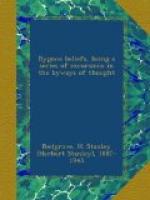[2a] ARTHUR H. COLLINS, M.A.: Symbolism of Animals and Birds represented in English Church Architecture (1913).
[1] A Kabalistic process by which a word is formed by taking the initial letters of a sentence or phrase.
It was a belief in the spiritual or moral significance of nature similar to that of the mystical expositors of the Bible, that inspired the mediaeval naturalists. The Bestiaries almost invariably conclude the account of each animal with the moral that might be drawn from its behaviour. The interpretations are frequently very far-fetched, and as the writers were more interested in the morals than in the facts of natural history themselves, the supposed facts from which they drew their morals were frequently very far from being of the nature of facts. Sometimes the product of this inaccuracy is grotesque, as shown by the following quotation: “The elephants are in an absurd way typical of Adam and Eve, who ate of the forbidden fruit, and also have the dragon for their enemy. It was supposed that the elephant . . . used to sleep by leaning against a tree. The hunters would come by night, and cut the trunk through. Down he would come, roaring helplessly. None of his friends would be able to help him, until a small elephant should come and lever him up with his trunk. This small elephant was symbolic of Jesus Christ, Who came in great humility to rescue the human race which had fallen `through a tree.’ “[1]
[1] A. H. COLLINS: Symbolism of Animals, etc., pp. 41 and 42.
In some cases, though the symbolism is based upon quite erroneous notions concerning natural history, and is so far fantastic, it is not devoid of charm. The use of the pelican to symbolise the Saviour is a case in point. Legend tells us that when other food is unobtainable, the pelican thrusts its bill into its breast (whence the red colour of the bill) and feeds its young with its life-blood. Were this only a fact, the symbol would be most appropriate. There is another and far less charming form of the legend, though more in accord with current perversions of Christian doctrine, according to which the pelican uses its blood to revive its young, after having slain them through anger aroused by the great provocation which they are supposed to give it. For an example of the use of the pelican in church architecture see fig. 36.
Mention must also be made of the purely fabulous animals of the Bestiaries, such as the basilisk, centaur, dragon, griffin, hydra, mantichora, unicorn, phoenix, etc. The centaur (fig. 39) was a beast, half man, half horse. It typified the flesh or carnal mind of man, and the legend of the perpetual war between the centaur and a certain tribe of simple savages who were said to live in trees in India, symbolised the combat between the flesh and the spirit.[1]
[1] A H. COLLINS: Symbolism of Animals, etc., pp. 150 and 153.




